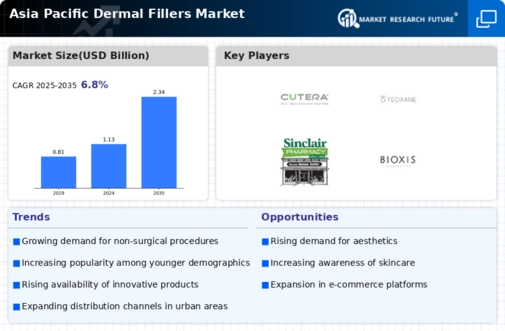Asia Pacific Dermal Fillers Market Summary
As per Market Research Future Analysis, the Asia Pacific Dermal Fillers Market was valued at 1.13 USD Billion in 2024 and is projected to grow to 2.33 USD Billion by 2035, with a CAGR of approximately 6.80% from 2025 to 2034. The market growth is driven by increasing demand for non-invasive cosmetic procedures, a growing aging population seeking facial rejuvenation, and advancements in dermal filler technologies.
Key Market Trends & Highlights
The Asia Pacific Dermal Fillers Market is experiencing significant growth due to various factors.
- Market Size in 2024: 1.13 USD Billion
- Projected Market Size in 2034: 2.19 USD Billion
- CAGR from 2025 to 2035: 6.80%
- Dominant Segment: Hyaluronic acid (HA) fillers due to their adaptability and efficacy.
Market Size & Forecast
| 2024 Market Size | USD 1.13 Billion |
| 2035 Market Size | USD 2.33 Billion |
| CAGR (2025-2035) | 6.80% |
Major Players
Key companies include Cutera Inc, Galderma SA, Teoxane Laboratories, Sinclair Pharma, Revance Therapeutics, Elan Aesthetics Inc, Vital Esthetique Laboratories, Merz Pharma GmbH and Co. KGaA, Bioxis pharmaceutical, and AbbVie Laboratories.















